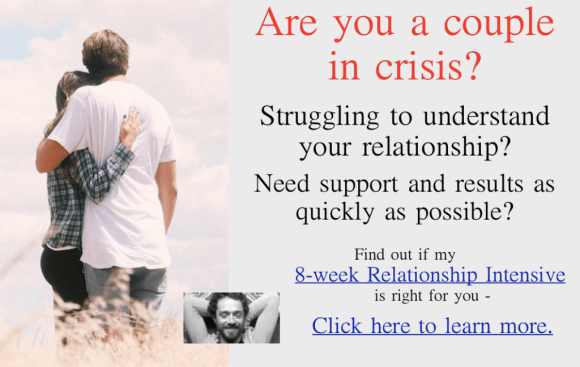 When faced with our partner’s difficult feelings, the reflexive response tends to be some version of this: “Stop feeling that.” We might dress up our response in language that sounds more caring or compassionate, but the essential meaning of our message – stop feeling that – rings loud and clear.
When faced with our partner’s difficult feelings, the reflexive response tends to be some version of this: “Stop feeling that.” We might dress up our response in language that sounds more caring or compassionate, but the essential meaning of our message – stop feeling that – rings loud and clear.
We want our partner to stop feeling what they are feeling because it makes us uncomfortable in a hundred ways. Until we examine the discomfort that their feelings activate in us, we will continue to respond with some version of “Stop feeling that.” The problem with this response is that it easily turns the partner’s feelings into a point of contention, defensiveness follows, and a familiar escalation of conflict is often not far behind.
The alternative?
Another possibility is to respond to our partner’s difficult feelings with some version of this: “Please tell me more.” The problem with this is that it conflicts with our true intentions and desires. “Please tell me more” is a nice idea, but the truth is that we don’t want our partner to tell us more; we want them to stop feeling that.
Who would we have to be in order to genuinely want our partner to tell us more about their difficult feelings?
First, we’d have to be someone who can tolerate our partner’s difficult feelings. This is no small task. When the people closest to us are feeling something difficult, it is virtually impossible to not feel anxious. How we manage this anxiety determines our ability to be curious about their experience rather than trying to avoid, control, or fix it. In other words, our ability to be present in relationship hinges our ability to tolerate or manage the anxiety we feel.
Many of the complaints I hear in my marriage counselling practice come down to this –
“My partner doesn’t listen to me; they try to fix me or control me. I just want to be heard.”
Of course, the person saying this isn’t always telling the whole truth. Often there is a secret desire to have our partner rescue us, or there’s a not-so-secret attempt to pin our feelings on our partner, which makes it even harder for them to just “be with us” when we are suffering. There can also be an expectation that our partner demonstrate sufficient understanding, acknowledgement, or agreement when we reveal our feelings.
These dynamics can best be seen in the context of a “relationship system.” Thinking of relationship in terms of a system means acknowledging that relationship dynamics can’t be reduced to a simple cause and effect, but rather that there are multiple inputs that shape the system in complex ways, and that each person in the system has a part in either maintaining or changing it, no matter if they see themselves as the protagonist or the antagonist.
Learn more about tolerating feelings and changing difficult relationship dynamics in my book The Re-Connection Handbook for Couples.
Follow me for sex and relationship tips, tools, and insights – Facebook | Instagram
Like what you’re reading here?
You’ll love my book.
Read the first 10 pages free.
 Trying to grow, fix, change, understand or save your marriage? I provide couples therapy, marriage counselling, coaching and mentoring to individuals and couples on the issues that make or break relationships – Sessions by telephone/skype worldwide. Email justice@justiceschanfarber.com to request a client info package. www.JusticeSchanfarber.com
Trying to grow, fix, change, understand or save your marriage? I provide couples therapy, marriage counselling, coaching and mentoring to individuals and couples on the issues that make or break relationships – Sessions by telephone/skype worldwide. Email justice@justiceschanfarber.com to request a client info package. www.JusticeSchanfarber.com
Sign up to get my articles by email –
Like this article? Share it! You can use the buttons below –




